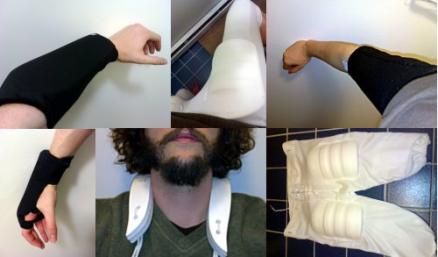anthropometrics
ScanBand v0.2

Version 0.2 of scanband increases the size of the measuring window to 5 mm and adds a colored warning strip to allow for quick diagnosis of dangerously diminished mid-upper arm circumference. The barcode gradient in this might be inverted (snafu) and the strip still needs a numerical readout. Also, a window system that folds over the strip, rather than relying on cut slits, would be easier to fit on patients.
- Comments



- 9832 reads
First Outside Critic Presentation
ScanBand v0.2Thursday night marked the first presentation of my thesis work to outside critics. It went well, despite a snafu with the barcode scanner that prevented the ScanBand from displaying its results on screen. As a non-digital user scenario, though, it was fine.
Here's the breakdown of my presentation. I've also attached the PDF of the show and a PDF of the version 0.2 ScanBand prototype, which is made available under the Creative Commons Attribution-ShareAlike License 3.0
- Mike's blog
- Comments
- Read more



- 3517 reads
Comfort, Wearables, and a Peripersonal Space Experiment
I've been doing a lot of work on anthropometrics, and I found the articles for this week to be really helpful for my thesis research. I have been thinking about how to measure vital signs on a patient's body in a way that is inexpensive, accurate, and user-friendly, both for the patient and the technician. Equally important, however, is that a measuring device should be wearable, by the authors' definitions, if only for a short time.
In "The Comfort Assessment of Wearable Computers," by James Knight, et al., the authors invented a multidimensional test for describing the feelings of comfort or discomfort for a wearable device. I'm a freak for numbers and hard data, so it's nice to have this tool available to me for evaluating prototypes. I am especially glad to see how the evaluations are broken down, getting rid of the unhelpful, single variable comfortable/uncomfortable and allow researchers to get more toward the point of what actually is making the user uncomfortable with a device.
More specific to the design of the devices themselves, in "Design for Wearability" Gemperle et al. delineated the constraints for device placement, form, allowance of movement, peripersonal space, attachment, and several other considerations. For me, this could work as a checklist as I create new devices and wearables, making sure I've considered all of the problem areas. I especially appreciated their breakdown of good places to site the devices, which helps give me a starting point for how to shape and attach them.
Rounding out the readings, Dunne and Smyth's "Psychophysical Elements of Wearability" dove more into the neurological side of comfort, which I also liked. I have done a bit of work with haptic interfaces before, and the deadening of response to a continuous stimulus is something I've noticed. If you want the user to notice an output, the stimulus must be fresh. On the flip side, if you want the user to not attend to the device, it must be comfortable (that is, it must not irritate the nerves.)
I think the Dunne and Smyth article sums up something for me that I have been thinking about for a while. For a wearable to be successful, in my opinion, it must be peripheral. In their terms, it must be something that is subconsciously processed but not attended to. Important input from the wearable may be perceived by the user and later attended to, but it should otherwise fall into the background noise of the rest of the world.
With all this in mind, I conducted a little experiment with some equipment I picked up at Modell's, a local sporting goods chain store. I picked up a set of Adams Forearm Pads, Adams Football Pants, Adams Football Thigh Pads, Adams Neck Roll (flat contour), a pair of Trace Hand-Guard Plus, Nike Dri-FIT Sliding Pad, and a Nathan L.E.D. Wrist Runner. I put on the pants with the thigh pads inserted, put the forepad on my left forearm, the sliding pad on my upper right arm with the thickest part on my tricep, put the neck roll loosely over my shoulders, and put the hand guard on my left hand. Then I performed ordinary tasks to see how I reacted to these additions to my body in daily life.
 Collage of Sports Protection Equipment: First row: Adams Forearm Pad, Adams Football Thigh Pad, Nike Dri-FIT Sliding Pad Second row: Trace Hand-Guard Plus, Adams Neck Roll (flat contour), Adams Football Pants
Collage of Sports Protection Equipment: First row: Adams Forearm Pad, Adams Football Thigh Pad, Nike Dri-FIT Sliding Pad Second row: Trace Hand-Guard Plus, Adams Neck Roll (flat contour), Adams Football Pants
- Mike's blog
- Comments
- Read more



- 12018 reads
- « first
- ‹ previous
- 1
- 2
- 3
- 4
tags
Copyright Mike Edwards 2006-2009. All content available under the Creative Commons Attribution ShareAlike license, unless otherwise noted.
